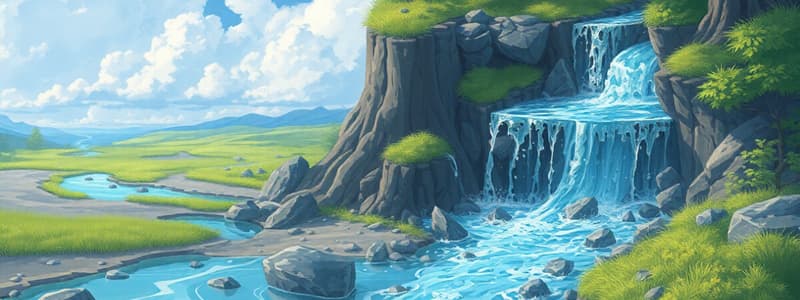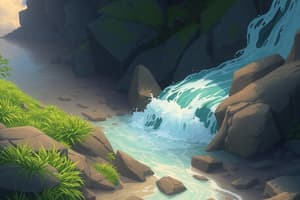Podcast
Questions and Answers
Which process describes water moving across the land surface when it cannot be absorbed into the ground?
Which process describes water moving across the land surface when it cannot be absorbed into the ground?
- Runoff (correct)
- Condensation
- Evaporation
- Infiltration
What is the primary force that drives infiltration of water into the soil?
What is the primary force that drives infiltration of water into the soil?
- Surface tension
- Wind pressure
- Evaporation rate
- Capillary action and gravity (correct)
Which of the following land cover types would likely result in the MOST runoff during a heavy rainfall event?
Which of the following land cover types would likely result in the MOST runoff during a heavy rainfall event?
- Permeable sandy soil with vegetation
- Agricultural field with cover crops
- Dense forest with thick leaf litter
- Impermeable paved parking lot (correct)
Where does runoff water typically accumulate as it flows downhill across the landscape?
Where does runoff water typically accumulate as it flows downhill across the landscape?
Besides soil type, which of these factors MOST directly influences whether precipitation will become runoff or infiltration?
Besides soil type, which of these factors MOST directly influences whether precipitation will become runoff or infiltration?
Which factor generally leads to increased runoff?
Which factor generally leads to increased runoff?
What is the initial stage of the runoff process after precipitation reaches the ground?
What is the initial stage of the runoff process after precipitation reaches the ground?
Which of the following is a negative consequence of runoff?
Which of the following is a negative consequence of runoff?
What is the primary mechanism that drives infiltration of water into the soil?
What is the primary mechanism that drives infiltration of water into the soil?
Which soil characteristic is most conducive to high rates of infiltration?
Which soil characteristic is most conducive to high rates of infiltration?
Flashcards
What is Runoff?
What is Runoff?
Water that flows over the land's surface instead of soaking into the ground.
What is a non-porous surface?
What is a non-porous surface?
Areas like concrete or granite with little to no spaces for water to soak into.
What is Infiltration?
What is Infiltration?
The process of water moving from the surface into the ground, similar to a sponge soaking up water.
What is Permeability?
What is Permeability?
Signup and view all the flashcards
What is Porosity?
What is Porosity?
Signup and view all the flashcards
Runoff
Runoff
Signup and view all the flashcards
Infiltration
Infiltration
Signup and view all the flashcards
Evaporation
Evaporation
Signup and view all the flashcards
Condensation
Condensation
Signup and view all the flashcards
Infiltration Capacity
Infiltration Capacity
Signup and view all the flashcards
Study Notes
The Water Cycle: Runoff and Infiltration
- Water Cycle Components: Water exists in three states: liquid (rivers, lakes, oceans), solid (ice, snow), and vapor (air moisture, clouds). The water cycle involves these states changing and moving.
- Water Movement: Precipitation (rain, snow, sleet, hail) falls to Earth. Water can collect, runoff, infiltrate the ground, or be absorbed by plants/animals. Evaporation and transpiration return water to vapor form, completing the cycle.
- Runoff Defined: Runoff is water that flows across the land surface due to excess precipitation. It cannot be absorbed. It eventually reaches streams, rivers, and then the ocean.
- Infiltration Defined: Infiltration is the process of water soaking into the ground. It moves into soil pores and rock cracks. Gravity and capillary action pull the water downward.
Runoff in the Water Cycle
- Runoff Trigger: Runoff occurs when rainfall exceeds the ground's ability to absorb it.
- Runoff Path: Water from runoff travels downhill through various channels—ditches, creeks, ravines—eventually joining rivers and lakes, flowing towards the ocean.
- Runoff Factors:
- Soil Type: Impermeable surfaces (concrete, granite) lead to more runoff. Saturated ground also creates runoff.
- Precipitation Type & Rate: Heavy rainfall or rapid snow melt causes more runoff.
- Topography: Steep slopes lead to quicker runoff.
- Vegetation: Dense vegetation promotes infiltration.
- Runoff Process: Water accumulates as precipitation, flows across land surfaces to lower elevation, collects in waterways, and ends up in oceans. Parts evaporate, infiltrate, or get used by plants and animals.
- Runoff Outcomes: Runoff can cause erosion (moving materials) and deposition (dropping materials). It transports pollutants, which can harm ecosystems.
Effects of Runoff
- Erosion and Deposition: Runoff moves soil, rocks, and nutrients. This can damage farms.
- Pollution Transport: Runoff carries pollutants from various sources into waterways, harming aquatic life.
- Sedimentation: Runoff can deposit sediment in lakes and estuaries.
- Algae Blooms: Nutrients transported by runoff can lead to harmful algae blooms.
Infiltration in the Water Cycle
- Infiltration Defined: Infiltration is water seeping into the ground.
- Infiltration Conditions: Porosity (water holding capacity) and permeability (water flowing rate) are crucial for infiltration.
- Infiltration Factors:
- Soil Type: Porous and permeable soils lead to more infiltration.
- Vegetation: Plant roots and organic matter aid infiltration.
- Slope and Elevation: Shallow slopes and low-lying areas facilitate infiltration.
- Temperature: Warmer soil leads to faster infiltration than frozen soil.
Infiltration Process
- Water moves into the soil, filling pore space and cracks.
- Gravity and capillary action drive the downward movement.
- Infiltrated water replenishes groundwater and creates aquifers.
- Eventually, water reaches an area where the ground is fully saturated (water table).
Rate of Infiltration
- Infiltration Rate: Measured in inches per hour and depends on soil type and conditions.
- Influences:
- Grain size (larger, less tightly packed = faster)
- Vegetation (roots and organic matter)
- Slope (shallow = slower)
- Rainfall rate (slower rain = better absorption)
Infiltration Examples
- Impermeable Materials: Granite, concrete. These materials obstruct water absorption.
- Permeable Materials: Limestone (can create aquifers). Sand (high porosity and permeability). Clay (High porosity, low permeability).
Studying That Suits You
Use AI to generate personalized quizzes and flashcards to suit your learning preferences.




